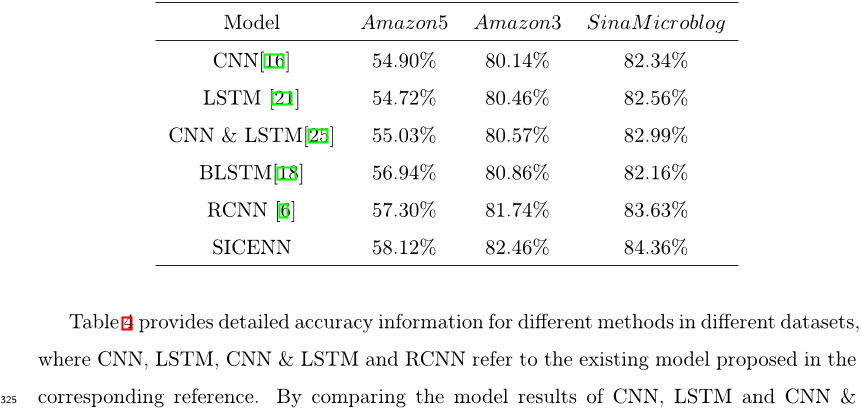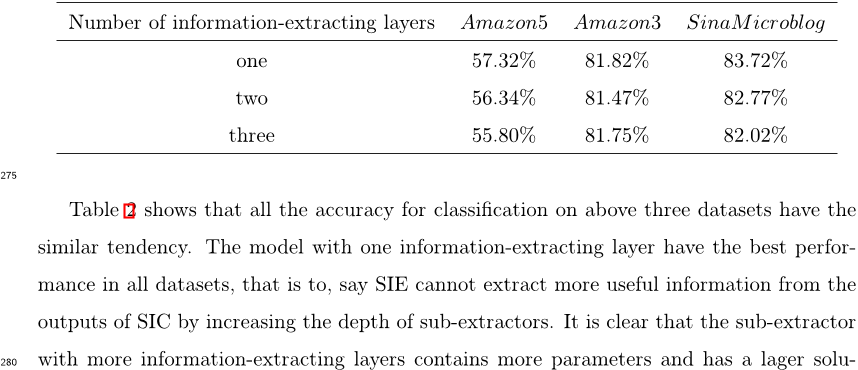A Sentiment Information Collector-Extractor Architecture Based Neural Network for Sentiment Analysis
Reads0
Chats0
TLDR
A new ensemble strategy is applied to combine the results of different sub-extractors, making the SIE more universal and outperform any single sub- Extractor and outperforms the state-of-the-art methods on three datasets of different language.About:
This article is published in Information Sciences.The article was published on 2018-10-01 and is currently open access. It has received 21 citations till now. The article focuses on the topics: Sentiment analysis & Deep learning.read more
Figures
Citations
More filters
Journal ArticleDOI
Carrying out consensual Group Decision Making processes under social networks using sentiment analysis over comparative expressions
Juan Antonio Morente-Molinera,Gang Kou,K. Samuylov,Raquel Ureña,Enrique Herrera-Viedma,Enrique Herrera-Viedma +5 more
TL;DR: This paper presents a novel model for experts to carry out Group Decision Making processes using free text and alternatives pairwise comparisons and introduces two ways of applying consensus measures over the Group decision Making process.
Journal ArticleDOI
A comparative study of machine translation for multilingual sentence-level sentiment analysis
TL;DR: This work evaluates existing efforts proposed to do language specific sentiment analysis with a simple yet effective baseline approach and suggests that simply translating the input text in a specific language to English and then using one of the existing best methods developed for English can be better than the existing language-specific approach evaluated.
Journal ArticleDOI
Convolution-deconvolution word embedding: an end-to-end multi-prototype fusion embedding method for natural language processing
TL;DR: In this paper, an end-to-end multi-prototype fusion embedding that fuses context-specific and task-specific information was proposed to solve the problem of polysemous-unaware word embedding.
References
More filters
Proceedings ArticleDOI
Attention-based LSTM for Aspect-level Sentiment Classification
TL;DR: This paper reveals that the sentiment polarity of a sentence is not only determined by the content but is also highly related to the concerned aspect, and proposes an Attention-based Long Short-Term Memory Network for aspect-level sentiment classification.
Proceedings ArticleDOI
Document Modeling with Gated Recurrent Neural Network for Sentiment Classification
Duyu Tang,Bing Qin,Ting Liu +2 more
TL;DR: A neural network model is introduced to learn vector-based document representation in a unified, bottom-up fashion and dramatically outperforms standard recurrent neural network in document modeling for sentiment classification.
Proceedings Article
Semi-Supervised Recursive Autoencoders for Predicting Sentiment Distributions
TL;DR: A novel machine learning framework based on recursive autoencoders for sentence-level prediction of sentiment label distributions that outperform other state-of-the-art approaches on commonly used datasets, without using any pre-defined sentiment lexica or polarity shifting rules.
Proceedings ArticleDOI
Sentiment analysis: capturing favorability using natural language processing
Tetsuya Nasukawa,Jeonghee Yi +1 more
TL;DR: This paper illustrates a sentiment analysis approach to extract sentiments associated with polarities of positive or negative for specific subjects from a document, instead of classifying the whole document intopositive or negative.
When Networks Disagree: Ensemble Methods for Hybrid Neural Networks
TL;DR: Experimental results show that the ensemble method dramatically improves neural network performance on difficult real-world optical character recognition tasks.




